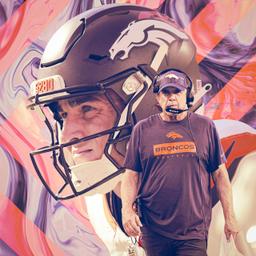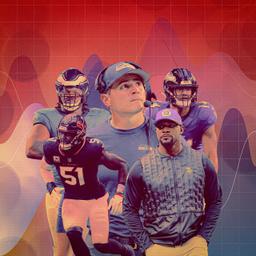In the 2024 offseason, NFL teams selected six quarterbacks in the first 12 picks of the draft, by far the most ever. As rookies, these passers had their ups and downs. One carried his team to the NFC championship game. One nearly set the record for sacks taken in a season. One never got a chance to play due to an injury.
Where do these players stand going into year two? Is this group still set to change the league—or were NFL teams overzealous when they drafted these guys back in April of last year? Welcome to Sophomore QB Week at The Ringer. This week, we’re breaking down the play and futures of Caleb Williams, Jayden Daniels, Drake Maye, Michael Penix Jr., J.J. McCarthy, and Bo Nix. Today, we’re looking at McCarthy, who missed his entire rookie season after tearing the meniscus in his right knee during the 2024 preseason.
It’s not an exaggeration to say that J.J. McCarthy’s 2025 season will be unprecedented. The 10th pick of the 2024 NFL draft missed his rookie season after tearing his meniscus last August, and, in doing so, he became the only first-round quarterback since 2000 to miss his first season due to an injury. Three other quarterbacks drafted in the first round didn’t take a single dropback during their rookie campaigns—Carson Palmer in 2003, Jason Campbell in 2005, and Jordan Love in 2020—but they were healthy and presumably got reps on the practice field. McCarthy, who had to navigate the Vikings facility on a scooter last season, had none of that. And when he starts his first NFL game in two weeks, a Monday-nighter in Chicago, he’ll have only 27 preseason dropbacks under his belt. In terms of pro experience, he’s arguably the rawest second-year starter in modern NFL history.
To that 22-year-old quarterback, the Vikings are entrusting a roster that won 14 games last season. And head coach Kevin O’Connell, who’s quickly building a reputation as a QB whisperer, hasn’t left himself an obvious alternative if this doesn’t work out. The Vikings let Sam Darnold walk in free agency after he threw for 4,319 yards and 35 touchdowns last season. They also said goodbye to Daniel Jones, who will be the Colts' starter in 2025. After exploring a possible connection with Aaron Rodgers this spring, O'Connell ultimately passed on the former MVP and settled on a quarterback room that has two nonthreatening backups: Carson Wentz, who just signed with Minnesota over the weekend, and Max Brosmer, an undrafted rookie. Even if McCarthy gets off to a slow start, nobody in Minnesota will be calling for the backups. For better or worse, this is now McCarthy’s show.
Given the fleeting nature of success in the NFL, the risk Minnesota is taking is obvious. If McCarthy isn’t ready to play, this will feel like a wasted year for a team that could be in championship contention with just above-average quarterback play. If he is ready, the Vikings could run away with the NFC North. That makes the second-year passer, who hasn’t started a game that counts since he won a national championship with Michigan 19 months ago, one of the main characters of the 2025 NFL season.
McCarthy’s unprecedented campaign will also double as a fascinating case study in quarterback development. How much football can a young passer learn without actually playing? O’Connell and the Vikings coaching staff have spent the past 12 months trying to figure that out, and they’ll get their answer over the next four months—or five, if everything goes according to plan.
To get an early sense of how things are progressing for McCarthy—and to get a rare look at how he operates in a competitive environment—I traveled to Minnesota in early August for the team’s joint training camp practices with the Patriots. “Competitive” may be a strong word to describe most training camp settings, but I’m not overselling it here. At least three full-fledged fights broke out on the second day of practices, and unsurprisingly, New England head coach Mike Vrabel found himself in the middle of one of them. The actual football was competitive, too. Vrabel said the Patriots even game-planned for the practices. He didn’t want his offense going up against a Brian Flores–coached defense without a sense of what to expect. And McCarthy goes up against that chaotic, tough-to-read unit every day.
“Having a thought pre-snap but always having to rely on that post-snap confirmation is huge,” McCarthy said of facing the Vikings defense. “Young quarterbacks can get caught with ‘I saw this, so I expected this.’ It’s like that every single play. They’ve got a lot of different pressures that expose you as an offense, and [that forces] communication with Ryan [Kelly] and Aaron [Jones] and Jordan [Addison]. It exposes us to a lot of looks that we’ll see in the season. … It’s a heck of a chess match.”
Practicing against a Flores defense can help a young quarterback get comfortable with uncomfortable situations, and Vrabel’s defense presents similar challenges. Coaches and players often say joint practices are more useful (and competitive) than preseason games, so this was as close to a real-world challenge as McCarthy has faced ahead of his NFL debut next month. On the first day, both offenses worked on second-and-long situations—aiming to get to third-and-manageable—and then played out the ensuing third down. O’Connell likes to work on these “weighty” or “hard” downs, as he calls them, because they test his offense—especially the quarterback—and they’re where defenses get creative with pressures and coverages and tend to produce sacks and turnovers.
“There’s going to be unscouted looks all over the field today,” O’Connell said ahead of the first day of joint practices. “This is not something where there’s 10 weeks of film on both sides and we can anticipate exactly how personnel are going to be used. … I think [Vrabel and I are] looking for the parts [the quarterbacks] can control to consistently be at the standard that we ask—and then to be able to evaluate the post-snap work to have a great understanding of where the player’s at.”
On the first day, McCarthy’s post-snap work was inconsistent. He made a few highlight-worthy throws and escaped from the pocket a couple of times, but he also had too many poorly placed passes and throws into coverage. That was to be expected for a young quarterback who hasn’t played a lot of football over the past 18 months, and that segment of practice was designed to put McCarthy in stressful situations. If O’Connell does his job well in the real games, his young quarterback won’t be seeing too many of those. The Vikings coach believes that’s where the coaching side of quarterback development tends to fall short around the NFL.
“You hear me use that term ‘hard down’ all the time,” O’Connell said in a radio interview at the start of camp. “I think too many people in this league force the young quarterback to play the hard down. And it’s hard enough. There’s no removing the difficulty of what playing the quarterback position is in the NFL. You can’t hide from a third-and-7. … But what are we [as coaches] doing all the other downs? What are we doing to put drives together, stack plays, marry the run and the pass?”
Although O’Connell has done a good job leading the Vikings offense over his first three seasons with the team, his unit hasn’t always made things easy on the quarterback. Minnesota has struggled to establish a consistently productive run game over the past three years, finishing outside of the top 20 in rushing efficiency in O’Connell’s first two seasons and then 18th in 2024. O’Connell has schemed his way out of enough “hard downs” to keep his offense rolling—having Justin Jefferson certainly helps with that—but if the Vikings are going to take the next step toward contention and set their young quarterback up for success, the 40-year-old coach knows things will have to look different.
“The longer you do it and the closer you get to becoming what you really want to be, you realize it can be a simple equation at that point: Can we get that yard when we need it?” O’Connell said. “Can we find a way to get those 3 or 4 or 5 yards and stack plays where maybe the job of the quarterback can be easier, the job of the world-class receiver can be easier, because we’re dictating in a different way than maybe we have at times over the last three years? All of that is still in the garage, but we have to become a little more complete in how we play football.”
Though the Vikings offense put up plenty of points in 2024, it lacked the balance and down-to-down efficiency O’Connell is seeking for this year’s group. The run game fell apart after a productive September, and the offense became reliant on explosive pass plays. Darnold proved to be a willing and able downfield passer, but sacks piled up, and the pass game eventually buckled under the pressure. In the team’s wild-card-round loss to the Rams, Darnold was sacked nine times. O’Connell may have coaxed a career year out of Darnold, but Minnesota wasn’t the most QB-friendly environment. The coach knows that needs to change—especially this season.
That would be a concern for any young quarterback, but McCarthy especially came into the NFL hearing questions about his ability to elevate an offense when conditions aren’t ideal. He didn’t have to do that often in Michigan’s run-first offense: McCarthy took the fewest dropbacks in his final college season (380) of any of the quarterbacks drafted in the first round last year, and he did that in 15 games. Jayden Daniels took the second fewest, 425, and he played just 12 games. Jim Harbaugh’s team didn’t put the playmaking onus on its quarterback. Instead, it cultivated an environment where, as long as McCarthy made the right checks at the line of scrimmage and got the ball into the appropriate receiver’s hands, the chains would keep moving. He played the role well enough to catch the eye of pro scouts. McCarthy is an NFL talent, so he had plenty of examples of impressive arm strength on his film, but it wasn’t his playmaking that made him a viable first-round prospect; his mature decision-making and stewardship of a pro-style scheme cemented that status.
McCarthy wasn’t seen as a prospect with a sky-high ceiling, which is becoming increasingly rare for first-round quarterbacks. He was seen as an intelligent passer with a good arm and enough athleticism to threaten defenses as a scrambler. I doubt the Vikings front office was looking to draft a system quarterback or game manager in the first round, but McCarthy wouldn’t be viewed as a massive disappointment if that’s what he ultimately amounts to.
As he did at Michigan, McCarthy operated the Vikings offense like a seasoned vet in camp, getting the offense to the line on time and making sure the protection was set correctly before the ball was snapped. In terms of pre-snap operation, McCarthy doesn’t look like a first-year starter leading the unit. And his value is most obvious when the Vikings are working on their early-down plays. There, he can play point guard and act as more of a distributor than a playmaker. It shouldn’t come as a shock that the quarterback has a firm grasp on pre-snap operation: McCarthy couldn’t do much outside of meeting rooms last year, so the Vikings went out of their way to maximize that time. He had a weekly hour-long meeting with O’Connell after most of the game plan was installed, allowing him to learn how it was put together and implemented on the practice field. Minnesota attached a camera to Darnold’s helmet in practice and set up a VR rig so McCarthy could watch practice reps play out through the quarterback’s eyes. Coaches had the rookie write out reference materials for the other quarterbacks based on that week’s game plan and asked him to put together profiles of opposing defensive coordinators.
All that work seems to have paid off, as was evident on the second day of joint practices. Following a shaky first day, McCarthy lit up the Patriots defense when the teams worked on red zone and two-minute situations. McCarthy’s handling of the offense before the snap was impressive, but it was his decisiveness after the snap that really stood out. He took chances downfield when they were there, connecting with Jordan Addison on countless plays. He hit his outlets when the downfield opportunities didn’t open up, and he scrambled when appropriate. At one point, McCarthy completed 12 passes in a row. “This is the one time it’s good that you guys were keeping some stats,” O’Connell joked after a reporter informed him of the feat. “It felt decisive. [He showed] an incredible amount of conviction in the decisions he made.”
McCarthy hasn’t had much of a chance to prove himself yet, but he’s already earned the confidence of his older teammates. Running back Aaron Jones compared McCarthy’s football IQ to that of his former teammate Aaron Rodgers. Jonathan Greenard, a defensive end who isn’t in offensive meeting rooms with McCarthy, recognizes the quarterback’s feel for the game from the other side of the line of scrimmage. “He knows when the defense is in zone coverage; he knows when it’s man or [Cover] Zero,” Greenard told me after practice. “He knows when he’s unaccounted for by the D-line and can slip through and make a play. He’s very, very intelligent and doesn’t get enough credit for it.”
Greenard says the Vikings defense has thrown everything it can at the second-year quarterback, and he has yet to see McCarthy blink. “He didn’t get any game reps last year, so I think this is the best way for us to prepare him—to give the offensive line our 100 percent best and make that gamelike feel where the pocket is collapsing. You still gotta go through your reads and try to make a play.
“I think he’s handled that really well,” Greenard continued. “He’s always encouraging us to [push it further]. Like, ‘Hey, keep sending that shit. I need the reps.’ I love that.”
McCarthy has checked a lot of the boxes you want from a young, aspiring franchise quarterback. He even opened his post-practice press conference by looking into the camera and thanking fans for coming out to camp. If he hadn’t pulled it off so naturally, I would have thought Vikings PR scripted it.
But if McCarthy doesn’t play well on the field, it won’t matter how well he handles the small stuff off of it. The most pressing issue in his game is his ability to throw with touch. By his own admission, McCarthy was a “one-speed-pitch kind of guy” at Michigan. O’Connell said McCarthy has worked on throwing with “different trajectories” and being able to layer the ball over a defender. “There might be a defender in front and a defender behind, and we’ve got to find a way to get that ball completed,” O’Connell said earlier in camp. “That's probably the biggest difference between college football and the NFL … the vertical voids.”
O’Connell said “there were definitely some throws where the maximum RPMs probably weren’t required” for McCarthy during OTAs, but his young quarterback threw with more finesse throughout training camp. He completed several touch throws on the second day with the Patriots, including a deep ball to Jones during a two-minute drill, which the quarterback picked out as his favorite throw of the day.
There were still plenty of instances where McCarthy could have shaved a few RPMs off a pass—and we saw one during McCarthy’s lone preseason appearance this August, when he tried to fire a straight-line pass over a linebacker to hit his receiver on an in-breaking route but sailed it over his head.
McCarthy threw a fastball when the situation called for a changeup—another learning experience for the first-year starter. And it’s one that the Vikings were unable to expose McCarthy to while he was injured last season. Even if Darnold had beaten McCarthy out for the job, the rookie quarterback would have gotten plenty of reps on the practice field. Vikings quarterbacks coach Josh McCown, who spent most of his NFL career on the bench and had to find ways to maximize his practice reps, says he was able to work on throws and test his limits as a scout team quarterback.
“It’s like going to the driving range,” McCown told ESPN. “It's where you get to practice all your clubs. There’s kind of no consequence, so to speak, and you really learn different types of throws that you can make in different windows. … And that’s the hardest thing that you don’t necessarily get to replace, just not being on the field.”
The Vikings put together a comprehensive plan to ensure that 2024 wasn’t a lost year for McCarthy, but there’s no substitute for getting out on the field and playing football. McCarthy has given his coaches and teammates every reason to believe he’s ready for the challenge that awaits him in 2025. They’ve seen the work he puts in to understand the offense. They’ve seen how that’s translated to the practice field, where he’s emerged as a team leader. The one thing they haven’t seen is how it will look when McCarthy takes the field in a game that counts—and how much this past year has prepared him for the real thing. We’re all about to find out together.








